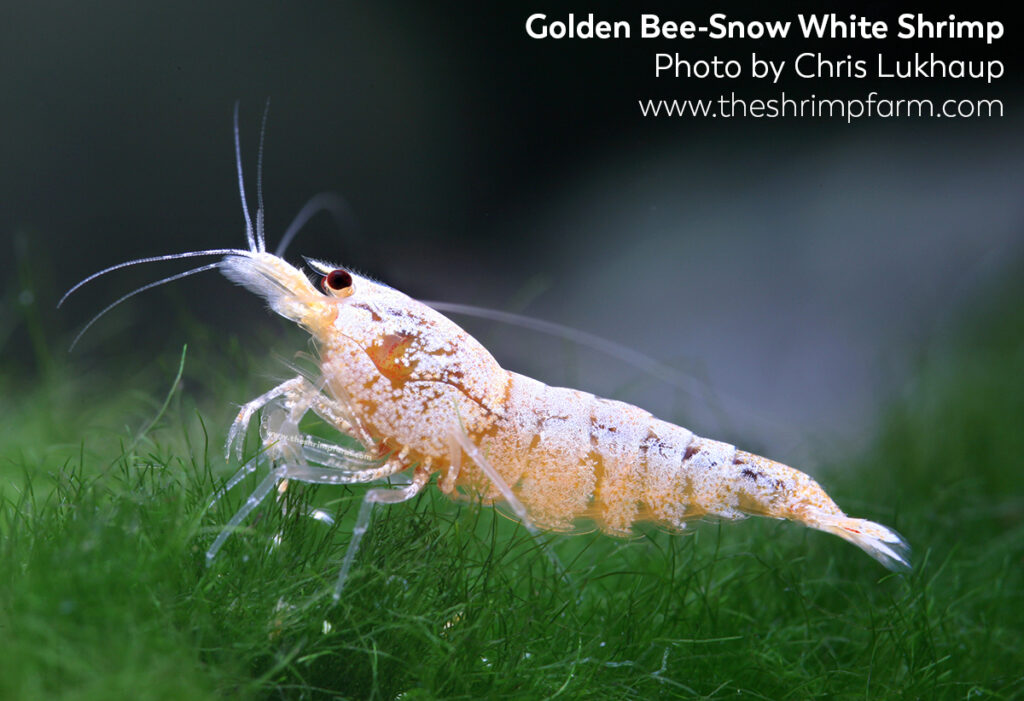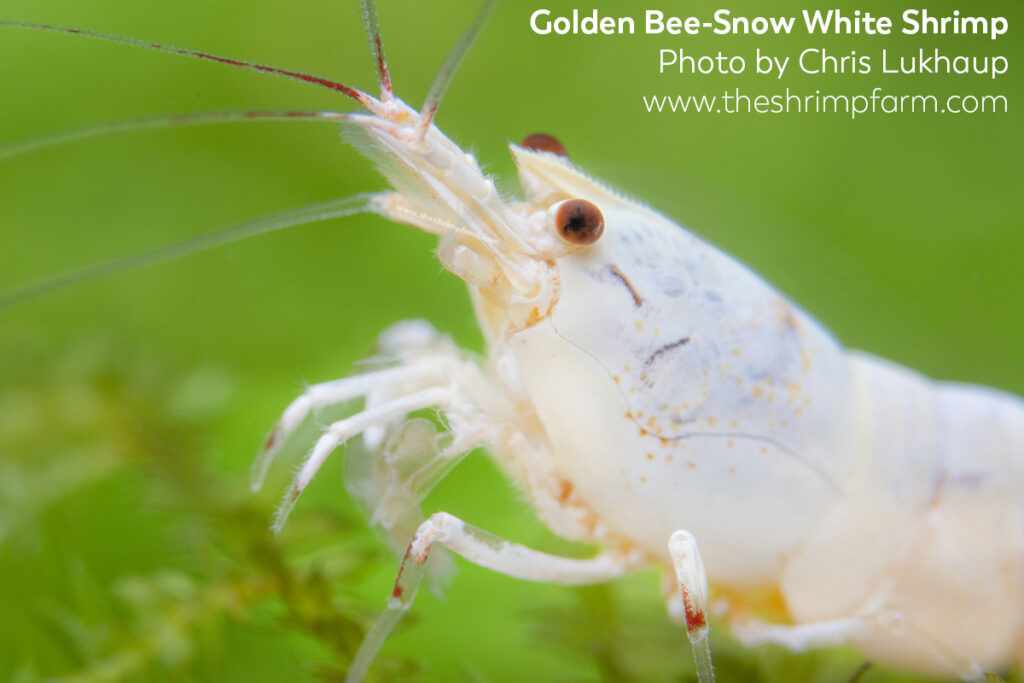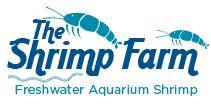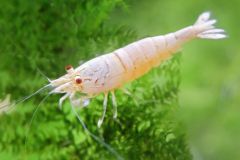Golden bee shrimp (Caridina cf. cantonensis) | Care & info
The golden bee shrimp is a bit of a mystery in the shrimp world: no one seems to be sure where it came from or who bred it. Like the much more common crystal red shrimp, it's a selectively bred variety of the bee shrimp. This species isn't the easiest dwarf shrimp to keep and breed, but its unique coloration certainly makes it worth the challenge.
Keep reading for everything you need to know about golden bees and keeping this Caridina cantonensis variety in your home aquarium.
| Scientific name | Caridina cf. cantonensis var. "Golden Bee" |
| Common names | Golden bee shrimp, golden crystal red shrimp |
| Difficulty level | Intermediate |
| Origin | Unknown |
Table of Contents
Golden bee shrimp appearance
Although the golden bee's carapace is snow white, its flesh is slightly orange-colored, which makes for a combination that looks almost golden. Really a striking shrimp to see!
Aside from its spectacular coloration, the golden bee shrimp is a typical Caridina cantonensis dwarf shrimp variety. It grows to a maximum size of around 1.5", with the males staying smaller than the females.
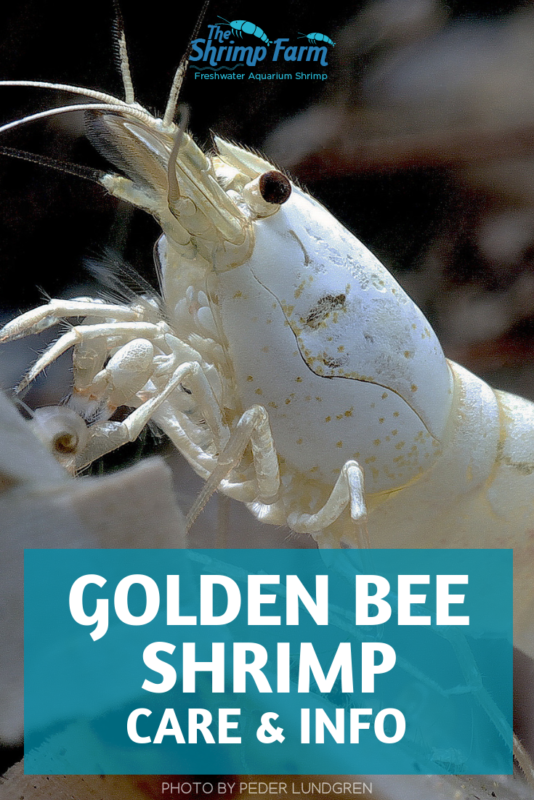
Setting up a golden bee shrimp aquarium
Requirements
If you're looking to start your own golden bee shrimp breeding project, you don't need a large aquarium. Around 10 gallons is preferable. Experienced aquarists might be able to keep the water quality high enough in a smaller tank, but that can be a little risky with these sensitive shrimp.
Equipment-wise, a filter is the most important. It allows the aquarium to cycle, which is crucial in keeping your shrimp alive and healthy. If you're not sure what cycling is, read this article first. A sponge filter should work well, as it produces a gentle flow and can't suck up any baby shrimp. If you're using another type of filter, be sure to attach a filter guard to protect your shrimp. A heater can help keep the aquarium temperature stable.
Like all shrimp, golden bees prefer an aquarium with plenty of hiding places. This can be as simple as tossing some Java moss into the tank or adding some ceramic or PVC pipes.
Water quality
Water quality is a crucial part of golden bee shrimp care. Unlike the sturdier Neocaridina davidi dwarf shrimp varieties, golden bees are quite sensitive. They won't respond well at all to bad water quality or sudden fluctuations.
To keep your golden bees happy and healthy, the aquarium water should be soft and relatively acidic. The set-up should always be fully cycled, as any traces of ammonia or nitrite can quickly prove fatal for these fragile shrimp. Nitrates should also be kept in check, since they are harmful in larger doses. Do regular water changes to lower your nitrates and keep a close eye on your water values using a liquid test kit.
pH: 5.8-7.4
Temperature: 62-76 °F
GH: 4-6
KH: 0-4
Total Dissolved Solids: 100-200
Tankmates
When it comes to tankmates, most serious shrimp breeders choose to skip them altogether. No tankmates mean no risk of any fish or invert bothering the shrimp, which in turn means less stress and higher rates of fry survival.
If you do want to keep your golden bee shrimp with other fish or invertebrates, be sure to choose very, very wisely. Almost all fish will eat tiny shrimp fry, so stick to very peaceful options like pygmy Corydoras catfish. These are too small to fit even a baby shrimp into their mouth. There are also a few shrimp-safe invertebrates. Most snail species, like nerite snails, should work well.
You can also combine your golden bees with other dwarf shrimp, as long as there's no risk of interbreeding (which means no mixing multiple bee shrimp varieties). Neocaridina davidi is perfect.
Golden bee shrimp diet
Wild bee shrimp survive by eating algae and biofilm off any surface they can find. Because our aquariums are usually too clean to contain enough natural foods, it's up to you to make sure your shrimp have enough to eat. There are many high-quality shrimp foods available that make great staples. A varied diet is key, though, so be sure to also include some of the various other foods that shrimp love. Fresh blanched veggies, frozen foods like mosquito larvae and leaf litter will all be appreciated.
Feed around once a day and be sure to remove any uneaten foods within a few hours to prevent pollution.
Breeding golden bee shrimp
Breeding golden bee shrimp is similar to breeding other dwarf shrimp. Females can easily be recognized, as they are larger and more intensely colored than males. The underside of their carapace is more rounded, and if they're healthy, they should almost constantly carry small brownish eggs. These hatch after around 30 days to reveal tiny copies of the parents, which can immediately fend for themselves and don't need special care.
The more opaque a golden bee's coloration, the higher the "quality". If you're breeding golden bees to sell, be sure to regularly remove shrimp that lack intense coloration to prevent the overall quality of your colony from decreasing. Many aquarists set up a special tank for the inferior quality "culls" so they can happily live out their lives.
Buying golden bee shrimp
Golden bees are still a relatively uncommon bee shrimp variety. This means they might not be the easiest shrimp to find and your local aquarium store probably doesn't carry them. You can ask them to order some golden bee shrimp for you, but you can also try the Internet.
Fellow shrimp hobbyists might have some golden bees for sale. The Shrimp Farm also sells golden bee shrimp: you can buy your golden bees here and have them shipped right to your doorstep.



 Shrimp
Shrimp Fish
Fish Crab &
Crab & Plants
Plants Foods
Foods Snails
Snails